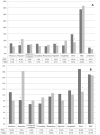Elderly emergency patients presenting with non-specific complaints: Characteristics and outcomes
- PMID: 29190706
- PMCID: PMC5708794
- DOI: 10.1371/journal.pone.0188954
Elderly emergency patients presenting with non-specific complaints: Characteristics and outcomes
Abstract
Background: Non-specific complaints (NSC) are common at the emergency department, but only a few studies have shown evidence that these complaints are associated with a poor prognosis in elderly emergency patients.
Objective: To describe patient characteristics and outcomes in a cohort of elderly emergency patients presenting with NSC. Outcomes were: patient characteristics, hospitalization, 90-day ED-return visits, and 30-day mortality.
Method: A retrospective cohort study was conducted amongst elderly patients present to the Internal Medicine Emergency Department (ED) between 01-09-2010 and 31-08-2011. NSC were defined as indefinable complaints that lack a pre-differential diagnosis needed to initiate of a standardized patient evaluation. Cox regression was performed to calculate Hazard Ratios (HR) and corrected for confounders such as comorbidity.
Results: In total, 1784 patients were enrolled; 244 (13.7%) presented with NSC. Compared to those with SC, comorbidity was higher in the NSC-group (Charlson comorbidity index 3.0 vs. 2.4, p<0.001). The triage level did not differ, but ED-length of stay was longer in the NSC-group (188 vs. 178 minutes, p = 0.004). Hospitalization was more frequent (84.0 vs. 71.1%, p<0.001) and the length of hospital stay (9 vs. 6 days, p<0.001 was longer in the NSC- than in the SC-group. The number of ED-return visits were comparable between both groups (HR 0.8, 95%CI 0.6-1.1). Mortality within 30-days was higher in the NSC- (20.1%) than in the SC-group (11.0%, HR 1.7 95%CI 1.2-2.4).
Conclusion: Elderly patients present with NSC at the ED regularly. These patients are more often hospitalized and have a substantially higher 30-day mortality than patients with SC.
Conflict of interest statement
Figures


References
-
- Samaras N, Chevalley T, Samaras D, Gold G. Older patients in the emergency department: a review. Ann Emerg Med 2010. September;56(3):261–269. doi: 10.1016/j.annemergmed.2010.04.015 - DOI - PubMed
-
- Salvi F, Morichi V, Grilli A, Giorgi R, De Tommaso G, Dessi-Fulgheri P. The elderly in the emergency department: a critical review of problems and solutions. Intern Emerg Med 2007. December;2(4):292–301. doi: 10.1007/s11739-007-0081-3 - DOI - PubMed
-
- Aminzadeh F, Dalziel WB. Older adults in the emergency department: a systematic review of patterns of use, adverse outcomes, and effectiveness of interventions. Ann Emerg Med 2002. March;39(3):238–247. - PubMed
-
- Safwenberg U, Terent A, Lind L. The Emergency Department presenting complaint as predictor of in-hospital fatality. Eur J Emerg Med 2007. December;14(6):324–331. doi: 10.1097/MEJ.0b013e32827b14dd - DOI - PubMed
-
- Lowenstein SR, Crescenzi CA, Kern DC, Steel K. Care of the elderly in the emergency department. Ann Emerg Med 1986. May;15(5):528–535. - PubMed
MeSH terms
LinkOut - more resources
Full Text Sources
Other Literature Sources

